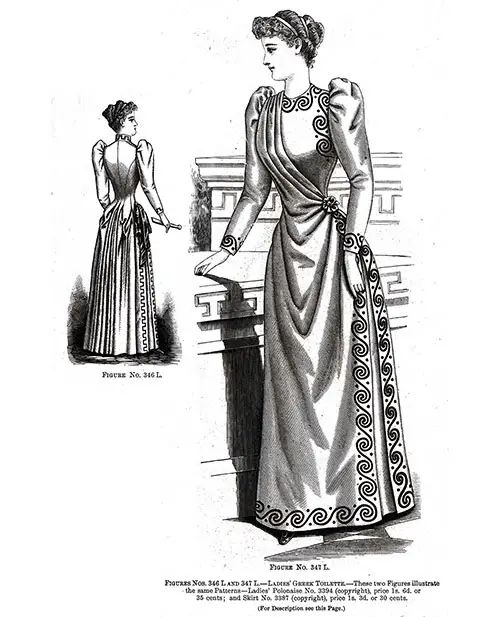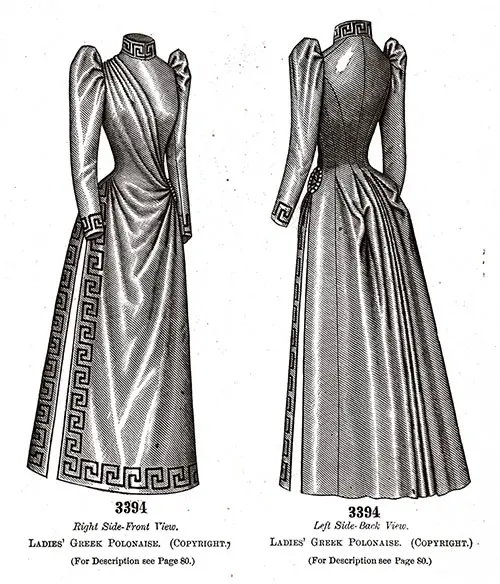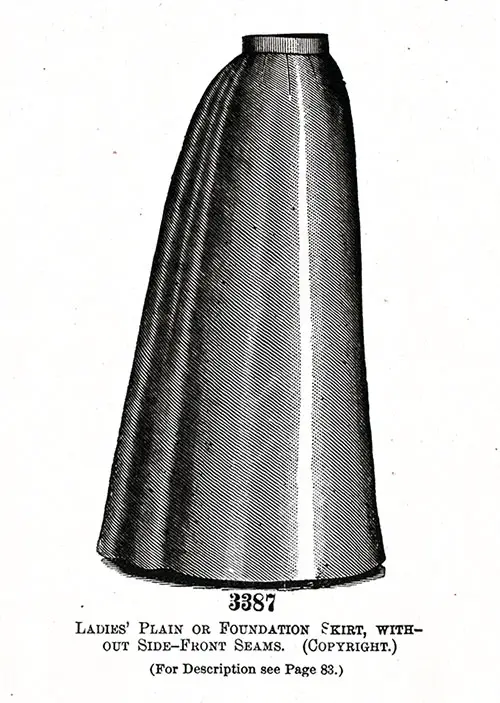Ladies Greek Costume 346 L and 347 L - 1890

Figure No. 346 L represents a back view of the costume, showing it developed in white serge, with, a bow of silk ribbon and a Greek-key border design wrought in gold braid for garniture.
At figure No. 347 L, which shows a front view of the costume, elaborate scroll and white serge are pictured again, and the medallion design worked with gold soutache braid provides the trimming. The plain skirt is fashioned without side-front seams and may be worn with or without a small bustle.
The polonaise has closely fitted under-fronts of lining, which are adjusted by double bust darts and closed at the center with hooks and eyes. At the left side is a plain front of basque depth that is widened and adjusted smoothly over the under fronts, the fullness below the bust being disposed in forward-turning plaits.
These plaits are concealed by the full right-front, which extends in Grecian style to the edge of the skirt, being drawn by gathers at the shoulder edge, disposed across the left front in surplice fashion and arranged in a cluster of upward-turning plaits at the left side, where it is fastened with a hook and loop beneath a rosette of ribbon to the left underarm seam.
A group of plaits in the right-side edge flare toward the center to correspond with those at the left side and produce a series of graceful curves and wrinkles across the front.
The fine adjustment is completed by the customary gores and a curving center seam that disappears at the top of an under folded double box-plait.
A slightly bouffant effect is achieved by stylish bournous loops falling inward at the side-back seams, upward-turning plaits in the front edges of the side-backs and loopings to an under-tape.
The side edges of the back-drapery fall like the corresponding edges of the front-drapery and hang in long, unbroken lines, and between the draperies, the skirt beneath is conclusively revealed.
The sleeves are stylishly full above the elbows, and tackings to the coat-shaped linings preserve the high effect so much admired. A standing collar provided by the pattern is omitted here, and the neck is finished in classic style with a scroll design wrought in gold braid.
Similar trimming decorates the left arm’s-eye, follows the square outline of the draperies, and forms a pretty wrist finish.
Costume Options
The costume will develop attractively in Henrietta cloth, serge, camel-hair, and all fabrics of a soft, clinging nature. One material may be used throughout, or velvet may be employed for the sleeves, its richness of texture serving to emphasize the classic folds that are shown to best advantage in woolens.
Passementerie, lace, galloon, and various other trimmings may be added, but a simple scroll or Greek-key design is always liked.
Illustration and Pattern Information
Figure Nos. 346 L and 347 L. — These two figures illustrate the same patterns -a Ladies’ Costume, which, consists of a polonaise and skirt.
The Polonaise, pattern, which is No. 3394 and costs Is. 6d. or 35 cents, is in thirteen sizes- for ladies from twenty-eight to forty-six inches, bust measure, and is portrayed differently on page 81 of this Delineator.
The skirt pattern, which is No. 3387 and costs Is. 3d. or 30 cents, is in nine sizes for ladies from twenty to thirty-six inches, waist measure, and may be seen again on page 85.
Terminology
Soutache: a narrow, flat ornamental braid used to trim garments.
Ladies’ Greek Polonaise Pattern No. 3394.

No. 3394. — Other illustrations of this polonaise are given at figures Nos. 346 L and 347 L (above) in this Delineator, where it is shown made of white cashmere and trimmed with gold soutache braid.
The polonaise illustrated here is made of plain suit fabrics and decorated with braid. The fronts are arranged over basque fronts o lining that are tightly fitted by double bust darts and closed down the center.
The left front is only the depth of the lining, while the right front forms tire long Greek apron, which falls in the original square outline to the edge of the skirt.
The left front laps widely beyond the closing of the fitted fronts and are without darts, the fullness below the bust being laid in three plaits that extend to a short distance above the lower edge at the right side.
The right front crosses the left front diagonally from the right shoulder to the left hip and gathers achieve a becoming surplice or drapery effect in the shoulder edge, the fullness being drawn to the left hip, where it is laid in upturning plaits.
A cluster of plaits laid in the left side edge over these plaits and a corresponding cluster in the right-side edge form graceful wrinkles in the drapery, the edges of which are followed by a Greek-key design done with braid.
A fancy buckle is placed over the plaits in the left side, with very decorative effect. The back is in Princess style and is exquisitely adjusted by under-arm and side-back gores and a well curved center seam.
The handsome fullness of the back-drapery is due to a wide double box-plait under folded at the end of the center seam and to extra widths at the side-back seams that fall inward in small bournouses.
A slightly bouffant effect is achieved by loopings to an under-tape and by a deep, upturning plait that falls diagonally into the drapery from the front edges of the side-backs.
The under-arm gores fall free from the front-drapery, the loose edge of the right gore being decorated to correspond with the front-drapery. At the neck is a high standing collar decorated with braid in Greek-key design, and the wrists of the handsome sleeves show a similar trimming.
The sleeves fit smoothly below the elbow but are gathered to stand high and full at the top; they are made up over coat-shaped linings, to which they are tacked near the top to hold the fullness out in pretty folds.
Costume Options
The costume is beautifully developed in softly falling materials, such as India and China silk, challis, cashmere, nun’s-vailing, camels-hair, sateen, mull, lawn, silk muslin, etc.
Velvet ribbon, narrow braids, Vandyke laces and embroideries, passementeries and galloons will form suitable trimmings.
The fronts may be made of contrasting materials, with beautiful effect, and a skirt matching either front may be worn. The collar may be omitted if the low effect at the neck is becoming.
A pretty polonaise made up by this pattern for a blonde may be of white China silk, the mode showing to advantage its soft, clinging nature. The loose edges have a beautiful border decoration of pale-blue forget-me-nots in natural colors.
Pattern Information
We have pattern No. 3394 in thirteen sizes for ladies from twenty-eight to forty-six inches, bust measure.
For a lady of medium size, it will require eleven yards and seven-eighths of material twenty-two inches wide, or seven yards and a-half, thirty-six inches wide. If goods forty-four inches wide be chosen, six yards will prove sufficient.
Price of pattern, 1s. 6d. or 35 cents.
Ladies’ Plain or Foundation Skirt, Without Side-Front Seams No. 3387.

No. 3387. — This skirt is shown again at figures Nos. 346 L and 347 L in this Delineator.
The skirt is here portrayed made of Silesia. The front and sides are cut in one piece, thus doing away with the three gores peculiar to the four-gored walking-skirt.
This piece, however, hangs with similar effect and is smoothly fitted at the top by three darts at each side of the center, and its back edges are joined to the front edges of a full back-breadth, the fulness of which is regulated by a row of coarse gathers.
The top of the skirt is finished with a belt, and tapes are sewed to the seams to draw the fullness backward. A placket opening is made at the center of the back-breadth, and a small bustle or any kind of improver may be worn.
Costume Options
The skirt may be appropriately worn under all styles of draperies and may be made of Silesia, cambric, Farmer satin, silk, alpaca, or any suitable material.
It will be found especially adaptable to the long, straight draperies now so popular. The bottom of the skirt will generally be faced for some distance with the dress goods.
Pattern Information
We have pattern No. 3387 in nine sizes for ladies from twenty to thirty-six inches, waist measure.
To make the garment for a lady of medium size will require four yards and five-eighths of material twenty-two inches wide, or three yards and a fourth, thirty-six inches wide, or two yards and three-eighths, either forty-four or fifty-four inches wide.
Price of pattern, 1s. 3d. or 30 cents.
"Figures Nos. 346 L and 347 L.—Ladies’ Greek Toilette," in The Delineator: A Journal of Fashion, Culture, and Fine Arts – Midsummer Number, New York: Butterick Publishing Co., Ltd, Vol. XXXVI, No. 2, August 1890, P. 75-76 (For Illustrations see Page 75).
"Ladies’ Greek Polonaise [No. 3394]," in The Delineator: A Journal of Fashion, Culture, and Fine Arts – Midsummer Number, New York: Butterick Publishing Co., Ltd, Vol. XXXVI, No. 2, August 1890, P. 80 (For Illustrations see Page 81).
"Ladies’ Plain or Foundation Skirt, Without Side-Front Seams [No. 3387]," in The Delineator: A Journal of Fashion, Culture, and Fine Arts – Midsummer Number, New York: Butterick Publishing Co., Ltd, Vol. XXXVI, No. 2, August 1890, P. 83 (For Illustrations see Page 85).
Editor's Note: Some terminology used in the description of women's clothing during the 1800s and early 1900s has been changed to reflect more modern terms. For example, a women's "Toilette" -- a form of costume or outfit has an entirely different common meaning in the 21st century. Typical terms applied to "toilette" include outfit, ensemble, or costume, depending on context.
Note: We have edited this text to correct grammatical errors and improve word choice to clarify the article for today’s readers. Changes made are typically minor, and we often left passive text “as is.” Those who need to quote the article directly should verify any changes by reviewing the original material.
